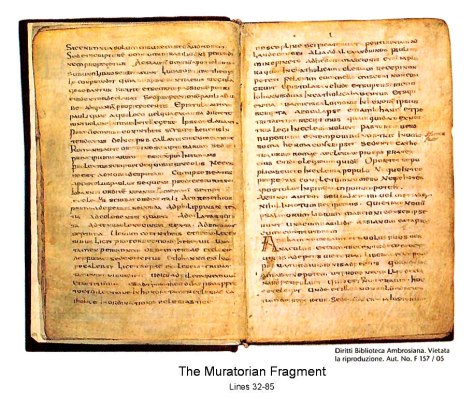
I thought it might be a good idea to write something about whether the Bible is generally reliable as a historical document. Lots of people like to nitpick about things that are difficult to verify, but the strange thing is that even skeptical historians accept many of the core narratives found in the Bible. Let’s start with a Christian historian, then go to a non-Christian one.
First, let’s introduce New Testament scholar Daniel B. Wallace:
Daniel B. Wallace
Senior Research Professor of New Testament StudiesBA, Biola University, 1975; ThM, Dallas Theological Seminary, 1979; PhD, 1995.
Dr. Wallace… is a member of the Society of New Testament Studies, the Institute for Biblical Research, the Society of Biblical Literature, the American Society of Papyrologists, and the Evangelical Theological Society (of which he was president in 2016). He has been a consultant for several Bible translations. He has written, edited, or contributed to more than three dozen books, and has published articles in New Testament Studies, Novum Testamentum, Biblica, Westminster Theological Journal, Bulletin of Biblical Review, the Journal of the Evangelical Theological Society, and several other peer-reviewed journals. His Exegetical Syntax of the New Testament is the standard intermediate Greek grammar and has been translated into more than a half-dozen languages.
Here is an article by Dr. Wallace that corrects misconceptions about the transmission and translation of the Testament.
He lists five in particular:
- Myth 1: The Bible has been translated so many times we can’t possibly get back to the original.
- Myth 2: Words in red indicate the exact words spoken by Jesus of Nazareth.
- Myth 3: Heretics have severely corrupted the text.
- Myth 4: Orthodox scribes have severely corrupted the text.
- Myth 5: The deity of Christ was invented by emperor Constantine.
Let’s look at #4 in particular, where the argument is that the text of the New Testament is so riddled with errors that we can’t get back to the original text.
It says:
Myth 4: Orthodox scribes have severely corrupted the text.
This is the opposite of myth #3. It finds its most scholarly affirmation in the writings of Dr. Bart Ehrman, chiefly The Orthodox Corruption of Scripture and Misquoting Jesus. Others have followed in his train, but they have gone far beyond what even he claims. For example, a very popular book among British Muslims (The History of the Qur’anic Text from Revelation to Compilation: a Comparative Study with the Old and New Testaments by M. M. Al-Azami) makes this claim:
The Orthodox Church, being the sect which eventually established supremacy over all the others, stood in fervent opposition to various ideas ([a.k.a.] ‘heresies’) which were in circulation. These included Adoptionism (the notion that Jesus was not God, but a man); Docetism (the opposite view, that he was God and not man); and Separationism (that the divine and human elements of Jesus Christ were two separate beings). In each case this sect, the one that would rise to become the Orthodox Church, deliberately corrupted the Scriptures so as to reflect its own theological visions of Christ, while demolishing that of all rival sects.”
This is a gross misrepresentation of the facts. Even Ehrman admitted in the appendix to Misquoting Jesus, “Essential Christian beliefs are not affected by textual variants in the manuscript tradition of the New Testament.” The extent to which, the reasons for which, and the nature of which the orthodox scribes corrupted the New Testament has been overblown. And the fact that such readings can be detected by comparison with the readings of other ancient manuscripts indicates that the fingerprints of the original text are still to be seen in the extant manuscripts.
Here is the full quote from the appendix of Misquoting Jesus:
“Bruce Metzger is one of the great scholars of modern times, and I dedicated the book to him because he was both my inspiration for going into textual criticism and the person who trained me in the field. I have nothing but respect and admiration for him. And even though we may disagree on important religious questions – he is a firmly committed Christian and I am not – we are in complete agreement on a number of very important historical and textual questions. If he and I were put in a room and asked to hammer out a consensus statement on what we think the original text of the New Testament probably looked like, there would be very few points of disagreement – maybe one or two dozen places out of many thousands. The position I argue for in ‘Misquoting Jesus’ does not actually stand at odds with Prof. Metzger’s position that the essential Christian beliefs are not affected by textual variants in the manuscript tradition of the New Testament.”
Finally, I think that the discovery of the Dead Sea Scrolls shows us that religious texts don’t change as much as we think they do over time.
Look:
The Dead Sea Scrolls play a crucial role in assessing the accurate preservation of the Old Testament. With its hundreds of manuscripts from every book except Esther, detailed comparisons can be made with more recent texts.
The Old Testament that we use today is translated from what is called the Masoretic Text. The Masoretes were Jewish scholars who between A.D. 500 and 950 gave the Old Testament the form that we use today. Until the Dead Sea Scrolls were found in 1947, the oldest Hebrew text of the Old Testament was the Masoretic Aleppo Codex which dates to A.D. 935.{5}
With the discovery of the Dead Sea Scrolls, we now had manuscripts that predated the Masoretic Text by about one thousand years. Scholars were anxious to see how the Dead Sea documents would match up with the Masoretic Text. If a significant amount of differences were found, we could conclude that our Old Testament Text had not been well preserved. Critics, along with religious groups such as Muslims and Mormons, often make the claim that the present day Old Testament has been corrupted and is not well preserved. According to these religious groups, this would explain the contradictions between the Old Testament and their religious teachings.
After years of careful study, it has been concluded that the Dead Sea Scrolls give substantial confirmation that our Old Testament has been accurately preserved. The scrolls were found to be almost identical with the Masoretic text. Hebrew Scholar Millar Burrows writes, “It is a matter of wonder that through something like one thousand years the text underwent so little alteration. As I said in my first article on the scroll, ‘Herein lies its chief importance, supporting the fidelity of the Masoretic tradition.'”{6}
A significant comparison study was conducted with the Isaiah Scroll written around 100 B.C. that was found among the Dead Sea documents and the book of Isaiah found in the Masoretic text. After much research, scholars found that the two texts were practically identical. Most variants were minor spelling differences, and none affected the meaning of the text.
One of the most respected Old Testament scholars, the late Gleason Archer, examined the two Isaiah scrolls found in Cave 1 and wrote, “Even though the two copies of Isaiah discovered in Qumran Cave 1 near the Dead Sea in 1947 were a thousand years earlier than the oldest dated manuscript previously known (A.D. 980), they proved to be word for word identical with our standard Hebrew Bible in more than 95 percent of the text. The five percent of variation consisted chiefly of obvious slips of the pen and variations in spelling.”{7}
Despite the thousand year gap, scholars found the Masoretic Text and Dead Sea Scrolls to be nearly identical. The Dead Sea Scrolls provide valuable evidence that the Old Testament had been accurately and carefully preserved.
I hope that this post will help those who think that we can’t get back to the text of the original New Testament documents.

